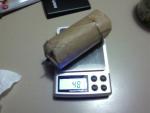That'll work excellently and it matches the blue I have made with CuCl2 - But the burning properties are better than mine since I rarely ever used hexamine (I used dextrin, PVC and shellac)! It seems like the hexamine is a bit high but perhaps the paper you lit it on is producing the orange tip in that video.
Good luck with your future devices.
Hi MDH,
This is my Cucl2 star test:
Do you think it's ok?.Thank you!




 Find content
Find content Not Telling
Not Telling

